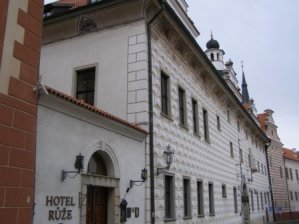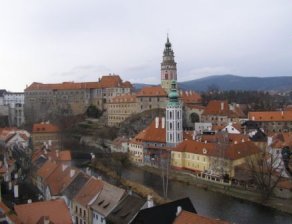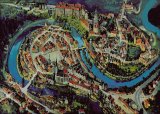32nd International Symposium on
Mathematical Foundations of Computer Science
August 26 – August 31, 2007
Location

MFCS 2007 will take place at:
| Hotel Růže |
| Horní 154 |
| 381 01 Český Krumlov |
| Czech Republic |
| Tel: +420 380 772 100 |
| Fax: +420 380 713 146 |
| e-mail: info@hotelruze.cz |
Český Krumlov, a UNESCO World Heritage Site, is a lively, cosmopolitan town with a unique atmosphere surrounded by unspoiled countryside. Dominated by a Castle stretching over the meandering Vltava River, Český Krumlov's narrow cobblestone streets wind along romantic nooks between patrician houses where you'll find attractive exhibits of world-renown artists, music festivals and concerts, and theatre performances. The cosy inns, coffee shops, and ancient taverns entertain a diverse international crowd.
You can also find Krumlov in Wikipedia or look at photos of the place.
Český Krumlov is ...

- a town of historical heritage – 300 protected buildings in the historical centre designated as a UNESCO World Heritage Site, the second largest castle complex in the Czech Republic, and the oldest Baroque theatre in the world
- a town of art and culture – Egon Schiele Art Centrum, International Art Gallery, 7 museums and 4 galleries, many art shops, 5 music festivals, theatre festivals, a revolving auditorium
- a town of many experiences – medieval festivals, beer tasting in the local brewery, historical wooden rafting along the Vltava river, night city tours and culinary specialities to enjoy
- a town for meetings and incentives – meeting halls, 5* and 4* hotels, exclusive historical spaces, castle garden, sports and historical games, culinary experiences
- a town surrounded by nature – hilly, green countryside perfect for hiking, biking, horseback riding, golfing, rafting and canoeing. The Lipno Dam and protected forests of Blanský les and the Šumava National Park are all within easy reach.
This charming town experienced its greatest prosperity during the rule of Lords of Rožmberk (1302–1602), who chose Český Krumlov to become the seat of their realm. At this time, Krumlov lied at the crossroads between the Czech, Austrian, Bavarian and Northern Italian lands. You can see the influence of these different cultures that have left their mark on the town and Castle with brushstrokes of the Italian Renaissance. At the end of 17th century, during the reign of House of Eggenberg, the Castle Baroque Theatre was built and the Castle Gardens were renovated. Under the rule of House of Schwarzenberg, Český Krumlov gained its Baroque appearance. Český Krumlov's Old Town hasn't experienced major changes since the 19th century, other than the demolition of the town's fortification walls and guard towers, and it has maintained its historic character.

